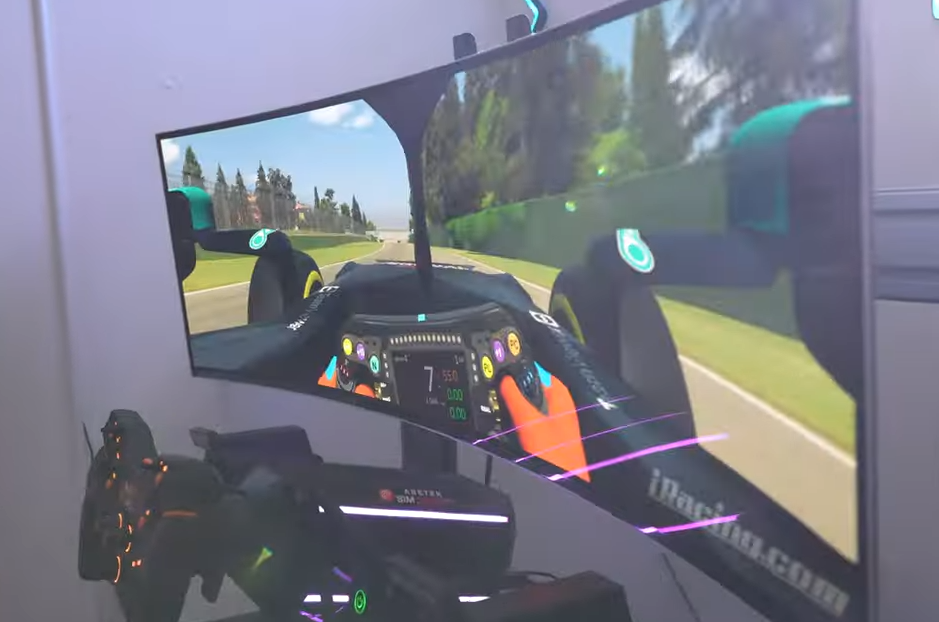
Why Your Display Setup Matters in Sim Racing
Sim racing has evolved from a casual pastime to a highly competitive, precision-driven experience. The display you choose—triple monitors or ultrawide—can impact reaction time, field of view (FOV), and overall immersion.
But the future of sim racing displays extends far beyond monitor size. Advancements in AI-powered displays, mixed reality (MR), and ergonomic optimizations are reshaping how we interact with racing sims.
This guide breaks down today’s top racing display choices, explores future display technology, and helps you make the smartest long-term investment.
1. The Evolution of Sim Racing Displays
The 1990s and early 2000s saw sim racers hacking together triple CRT monitor setups, borrowing techniques from flight simulators.
2017: The Turning Point – Samsung’s CHG90 (49-inch, 32:9 curved display) introduced a new era of ultrawide monitors, providing a single-screen alternative to triple setups.
2025 & Beyond: What’s Next?
- AI-Powered Eye-Tracking Displays – Adaptive FOV that dynamically adjusts as your eyes move.
- Mixed Reality Sim Rigs – Combining ultrawide monitors with holographic HUDs and VR overlays.
- OLED & MicroLED Ultra-Ultrawide (42:9) – 57-inch, 8K displays eliminating the need for multiple screens.
- Neural Interface Controls – Brain-controlled HUD adjustments & in-game telemetry interactions.
Long-term considerations: Will today’s monitor investments become obsolete within five years?
2. Field of View (FOV): The Science Behind Racing Immersion
A wider FOV enhances spatial awareness, reaction time, and depth perception—but only if calibrated correctly.
Scientific Insight: Does FOV Impact Racing Performance?
A 2018 University of Melbourne study found that sim racers with expanded FOV (180°+) experienced:
✅ 8% faster reaction times in high-speed racing scenarios
✅ 13% better spatial awareness compared to single-screen users
Triple Monitors: Maximum FOV, but at a Cost
✔️ 180°+ FOV – You can see side mirrors, apexes, and opponents approaching from behind.
✔️ Closest to real-life cockpit perspective.
❌ Bezel interference – Even ultra-thin bezels create visual distractions.
❌ Complex alignment – Calibration can be difficult.
Ultrawide Monitors: Seamless Immersion, but Limited FOV
✔️ Curved screens enhance depth perception – Feels more natural for the human eye.
✔️ Zero bezel distractions – A completely uninterrupted cockpit view.
❌ Max FOV ≈130° – Not as wide as triple setups.
Future-proofing thought: The human eye doesn’t see in a fixed FOV. Future displays may auto-adjust perspective dynamically based on real-time gaze tracking.
3. Performance Breakdown: FPS, GPU Load & Latency
Choosing between triple monitors vs. ultrawide isn’t just about visual clarity—it’s about hardware efficiency.
Triple Monitor GPU Demands
❌Rendering 3 screens triples GPU load
Requires RTX 4080+ for 1440p 144Hz performance
VRAM hungry – 10GB+ needed for high settings at 1440p
Ultrawide GPU Efficiency
✅ Single display = lower GPU strain
RTX 4070 can handle 5120×1440 at 144Hz
Higher frame rates, smoother performance
What if future AI-powered upscaling (like NVIDIA DLSS 4.0) allowed single ultrawide monitors to emulate triple screen FOV with minimal GPU cost?
4. Ergonomic & Psychological Factors: How Your Display Impacts Comfort
A 2019 Human Factors & Ergonomics Society study found that curved displays reduce eye strain by up to 24% compared to flat screens.
Triple Monitors & Physical Strain
✔️ Adjustable angles reduce neck strain
❌ Misalignments cause eye strain & distortion
❌ More head movement required – Can cause long-term fatigue
Ultrawide Monitors & Comfort
✔️ Curved screens follow natural eye movement
✔️ Less head movement required
✔️ Reduced long-term eye strain
Could AI-powered ergonomic tracking adjust monitor angles dynamically based on your posture and movement?
5. Cost Breakdown: Which Is the Smarter Investment?
| Feature | Triple Monitors | Ultrawide Monitor |
|---|---|---|
| Monitor Cost | $1,200+ (3 x 1440p, 144Hz) | $1,400-$1,800 (Samsung G9) |
| Mounting & Setup | $200+ (VESA mounts needed) | $50-$100 (single stand) |
| GPU Requirement | RTX 4080+ | RTX 4070+ |
| Power Consumption | Higher | Lower |
| Long-Term Upgrade Potential | ⚠️ Requires 3 monitor upgrades | ✅ Easier single upgrade |
AI-enhanced OLED displays could soon allow “dynamic resolution shifting,” eliminating the need for multiple screens altogether.
6. The Future of Sim Racing Displays: What’s Next?
By 2030, expect:
AI-Powered Dynamic Displays – Screens that adjust FOV, brightness, and depth perception based on real-time driver input.
Neural Interface Displays – Brain-controlled screen interactions with instant field of vision adjustments.
Mixed Reality Sim Racing (MR) – Combining ultrawide monitors with holographic HUD elements.
Long-term investment tip: If your rig lasts 5+ years, consider how new AI-driven display tech will impact your upgrade path.
Conclusion: Making the Right Choice for Your Sim Racing Setup
Choosing between ultrawide and triple monitor setups ultimately depends on your racing goals, budget, and desire for future-proofing. If you prioritize maximum FOV and a true-to-life cockpit experience, triple monitors remain the gold standard—especially for competitive racing. However, if you value simplicity, seamless immersion, and preparing for next-gen technologies, an ultrawide monitor is a powerful choice.
With AI-driven display technology, mixed reality rigs, and neural interfaces on the horizon, your display setup isn’t just a purchase—it’s an investment in the future of sim racing.
